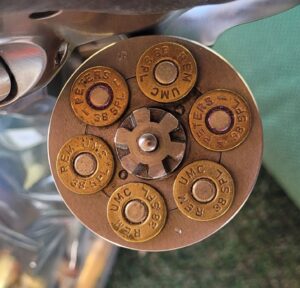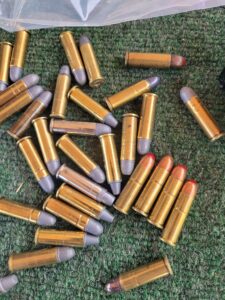Went to the range today to, among other things, function test the GP100 I picked up the other week. I brought along some of my usual .357 ammo, but I also had a dog’s lunch of .38 Special that had been cluttering up my shelf for a while. It was a mix of factory ammo, including tracers, going back quite a ways. None of it was newer than the 1990’s and some of it, like the tracers, were well past 50 years old. (Peters went defunct just after WW2)

 How’d they shoot? Well, I’d like to say it all shot fine but that’s not true. I had two failures due to light primer strikes. Both on the same brand/headstamp. I think what happened there was that the primers were seated a bit high. Both fired on the second strike. Everything else shot fine. And, yes, the tracers lit up…not 100%, but most of them. The ammo, however, did function and the bullets went downrange which is the important part.
How’d they shoot? Well, I’d like to say it all shot fine but that’s not true. I had two failures due to light primer strikes. Both on the same brand/headstamp. I think what happened there was that the primers were seated a bit high. Both fired on the second strike. Everything else shot fine. And, yes, the tracers lit up…not 100%, but most of them. The ammo, however, did function and the bullets went downrange which is the important part.
I bring this up because there is often the question of ‘how long is ammo good for’ or ‘how long will ammo last’. In addition to today’s episode, I’ve shot stuff a hundred years old that fired no problem. Heck, I had a buncha 1950’s vintage FN .30-06 ammo a few years back that fired perfectly. The answer to the question of how long ammo will last (and by ‘last’ we mean how long will ammo perform properly) is, basicaly, forever IF stored properly…in an airtight, moisture proof container, like an ammo can.
Now, having said that, do you know where the not-optimum storage place for ammo is? Your gun. The ammo you carry around in your gun on a day-to-day basis is exposed to elements, moisture from your body, and a few other environmental factors. And it will still work just fine years down the road. However…there is no point in taking chances so I personally fire off my carry ammo every so often and replace it. Usually annually, but Im kind of a paranoid that way. You can probably swap it out every other year and be just fine. For me, though, I swap it out every year.
So there you have it…stored properly ammo, in this case some .38 Special, will last a lifetime…easily. Class dismissed.

we had some bean bags at work that wouldn’t work after 2 years in the tx heat/humidity…so if you live in the south, you may want to swap out every year…
i often have to leave a gun in my truck. i change out the ammo every six months or so after i had a misfire. thank goodness it was just a target session.
When my uncle passed I got 6 ammo boxes with untouched, steel cased 45 ACP rounds from 1942. I have never had one not fire . I haven’t gone through the 30-06 yet but the lable says 1945.
One has to wonder about the variables. Is the chemical makeup of today’s gunpowder and primers the same as what they used in the 50’s? Modern priming compound is a mixture of lead styphnate, antimony sulfide, barium nitrate, and other chemicals. Who is to say that modern factories, based all over the world, are all using the same compounds in the same amounts? I’ve shot US rifle ammo with a 1944 headstamp and it shot fine. Given all the questionable stuff going on in the world today it’s hard to trust any company to not take short cuts.
Had some fun with some pre-WWI British Kynoch-cordite loaded ammo through the Enfield once upon a time Occasionally, it was like shooting a flintlock; click, brief interval, bang.
I have ammo I purchased in the 1980s that still shoots just fine. I have surplus ammo from before that; it also works.
After some ammo got waterlogged in a few inches of water in the basement, I started keeping all my ammo in…wait for it… ammo cans! While the cardboard boxes all melded together, the flooded 5.56 still fired and most of the 22LR did, too.
I read a story many years ago about a policeman who had a total ammo failure of his primary load in his revolver during a gun fight. I may be wrong, but I believe it was an article by Massad Ayoob( I hope I spelled this correctly). Upon investigation it turned out the officer removed his duty ammo during qualifications and replaced his duty ammo afterwards. The ammo in his revolver was almost 20yrs old. Your comments about ammo damage from the elements including body moisture are bang on. Bye the bye, he was wounded in the gunfight but able to reload and get back into action. He mightn’t have been too smart but he was a tough son of a…
TTFN Phil
We change out our duty ammo once a year and use the old duty to qualify. Ammo is cheap compared to a life lost because someone was too cheap in the supply chain!
I’ve shot .45-70 from the Indian Wars and .38 Long Colt from before the Span-Am war and had no issues.
It really is about storage conditions, not age.
Vibration is another thing to avoid in ammunition storage. It can mill the powder finer, jacking up the pressure.
Glovebox ammo stash, anyone?
This was really evident while shooting ARTY for USMC, slight variations cause major deviations when ruining someone’s day at 15+miles. As we shot mainly on Army posts we were often given “back of the bunker specials” in less than pristine conditions that they would not use.A lot of Vietnam surplus went down range that was older than a lot of Jr Marines and often worked fine but needed correction to hit target. The storage variable not mentioned is heat and the lifespan in the desert was very short compared to far North. Remember if zeroing a rifle to record the ammo used because it will change with different loads or even lots. Example of ammo abuse was Russian video of a Arty position that they had droned the gun and crew. The projectiles were just piled up on their sides. The explosive is semi fluid(think silly putty) and if laid on side will flow and the shot will be wildly inaccurate due to centrifugal force
These same guys were probably toasted by not being able to accurately hit targets.
Two weeks ago my wife bought a Glock 43X. A couple of days later, we decided to shoot it. I had an old ammo box with assorted 9mm I had thrown in it while cleaning out drawers and the garage. As sure as shooting I had three rounds of “Bear” ammo from the early 90s that sounded as if they barely detonated in a 15 round magazine. None of it cycled the slide. Each time I checked for squibs, but each time the barrel was clear. Many is the time my wife has washed a pair of britches with several .22 LR rounds. Those usually end up in a jar above the washing machine and are only used for plinking. I have experienced them misfiring and understandably so, but I don’t think that was the case with the 9 milly although it is possible. I have some 7.92X57 ammo I bought in the mid nineties of Turkish mfg. that dates from just after WW2 (1946/47). It is corrosive, but never fails to fire. At a friends house in TN a few years ago and we were shooting a MG42. We were loading belts with Romanian ammo from the early 60’s. The gun would jam about every 10th round. My friend had a several cases of wartime German surplus ammo dated 1939. I watched as he broke open the original wooden case revealing individual boxes of 15 rds. each. Those boxes were wrapped with a paper seal with proof/maker marks and the “dirty bird”. The history lover in cringed as he opened it. We loaded the belt and shot the entire case without a misfire. The gun never had a failure to feed or misfire. Ammo will last under normal conditions is my experience, but I keep my EDC loaded with “fresh ammo” just in case.